Removable spare wheel
If it is necessary to install a rolling spare wheel, the following requirements must be observed:
1. After installing the spare wheel, check the air pressure in its tire and bring it to the required value. The spare tire pressure should also be checked periodically and maintained when it is not needed.
Spare tire pressure

2. Reduced spare wheel («dokatka») should only be installed temporarily and placed back in the luggage compartment as soon as the main wheel has been repaired or replaced.
3. Installation «dokatki» It is not recommended to exceed the speed of 80 km/h.
4. The stowaway spare tire is designed to be fitted to your vehicle only and should not be fitted to any other vehicle model.
5. The tire of the spare wheel should not be mounted on the rim of any other wheel, nor should it be mounted on «prove» standard tires, winter tires and install a hubcap or decorative rings. This may cause damage to these or other parts of the vehicle.
6. If the tire is stored in the luggage compartment, the pressure in its tire should be checked monthly.

Full size spare tire
If a full-size spare wheel is fitted, the following instructions must be observed:
After installing the spare wheel, check the air pressure in it and bring it to normal. The air pressure must be checked periodically and maintained at the specified pressure while the spare wheel is in storage.
Spare tire pressure

Spare wheel handling
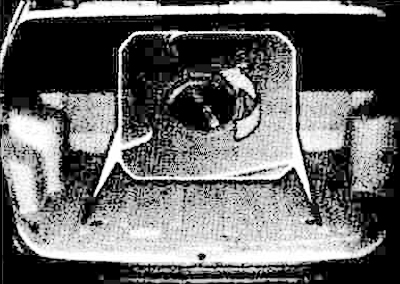
To remove the spare wheel:
1. Open the back door.
2. Remove the luggage compartment carpet.
3. Remove the lid of the lower luggage compartment by turning the lock knobs in the direction «UNLOCK» (Unlock).
4. Remove the lower luggage compartment box.

5. Take out a spare wheel, having turned away a bolt of its fastening. When installing the spare wheel in the compartment, hand-tighten the bolt securing it securely.
What to do in the event of a tire puncture
In the event of a tire puncture while driving:
1. Release the accelerator pedal and drive in a straight line when decelerating. Immediately after the puncture, do not slow down and do not turn off the roadway, because. this could result in loss of vehicle control. As soon as the speed decreases to a safe value, carefully slow down and turn off the roadway. Stop the vehicle as far away from the road as possible on firm and level ground. If you are on a freeway, do not stop your vehicle on the median.
2. After stopping the vehicle, apply the hazard warning lights, apply the parking brake and set the selector lever to the position «R» (by car with automatic transmission) or switch to neutral (in a car with a manual transmission).
3. Ask all passengers to get out of the car. Make sure that they get out of the car from the side opposite the road.
4. Replace the flat tire as follows.
Flat tire replacement

The operations described below are carried out both when changing wheels and when replacing a flat tire. Before changing a wheel, make sure the selector lever is in the «R» (by car with automatic transmission) or neutral on (in a car with a manual transmission) and the parking brake is on.
1. Prepare the spare wheel and tools.

Remove the spare wheel, jack and tool kit from the luggage compartment.
Note. The spare wheel is located under the luggage compartment floor.
2. Chock the wheel.

To prevent a jacked up vehicle from rolling, place chocks under the wheel diagonally opposite the flat tire on the opposite side of the vehicle.
3. Turn away nuts of fastening of a wheel.

Loosen the wheel nuts before lifting the vehicle. To loosen the nuts, turn the wrench counterclockwise, making sure that the head of the wrench fits snugly on the nut and does not come off. To obtain maximum force on the wrench, position its handle as shown in the figure. Then, holding the key near the end of the handle, push it down with constant force. At the same time, do not completely unscrew the nuts, but only loosen their tightening by half a turn.
4. Install the jack.

The jack is placed with its base on a hard horizontal surface as shown in the figure.
5. Vehicle lifting.
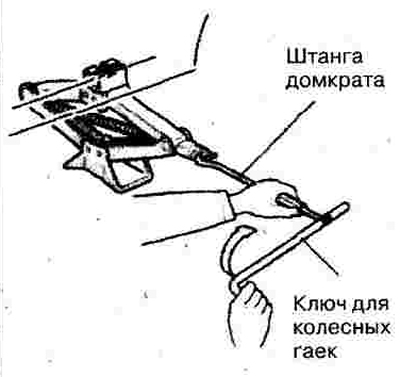
Insert the jack rod into the hole in the wheel nut wrench handle and attach the other end of the rod to the jack screw as shown. To raise the vehicle, turn the key clockwise. After starting to raise the car, check the reliability of the jack installation again. When placing the jack on soft ground or sand, place a plank, brick, flat stone, or other suitable object under the jack to keep it from sinking into the ground. Raise the vehicle to a height sufficient to accommodate a fully inflated tire. To do this, lift the car higher than is required to remove the flat tire.
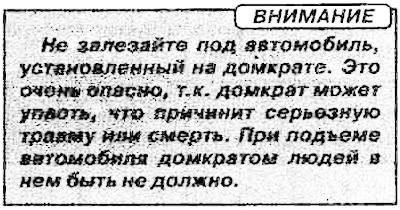
6. Wheel replacement.
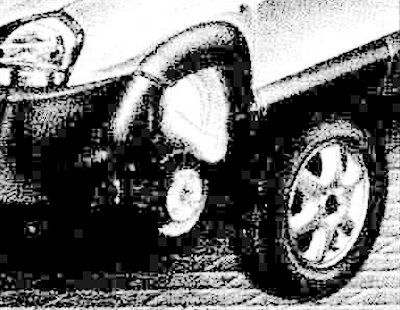
Loosen the wheel nuts even further, then unscrew them by hand. Remove the wheel from the hub studs and lay it on the ground to prevent it from rolling away. Take the spare wheel, align its holes with the hub studs and slide the wheel onto the studs. If that doesn't work right away, tilt the wheel and align its top hole with the top stud, then slide the wheel over the rest of the studs, rocking it back and forth.

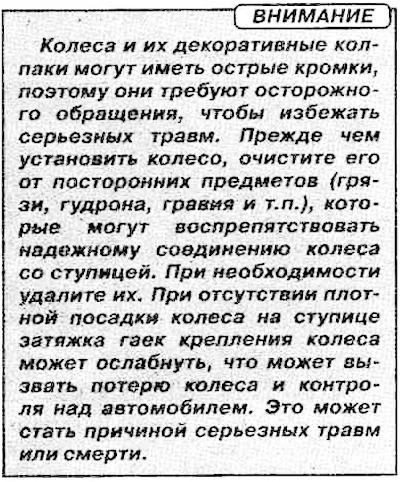
7. Wrapping the wheel nuts.

After installing the wheel, hand tighten the wheel nuts onto the studs with the smaller end facing the wheel. Make sure the wheel is properly seated by shaking it slightly, then tighten the nuts again as tight as possible by hand.
8. Lower the car and tighten nuts.
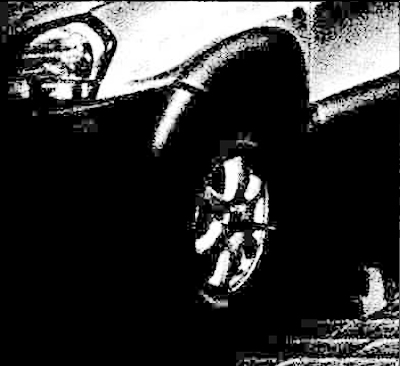
Lower the vehicle by turning the jack screw counterclockwise, then tighten the wheel nuts by installing the wrench as shown, making sure the wrench head is firmly seated on the nut. Do not press down on the wrench with your foot or increase the tightening torque with a wrench extension. Alternately tighten all nuts to failure, then check the tightness again. After installing the wheel, have the wheel nuts tightened to the correct torque as soon as possible.
Tightening torque for wheel nuts:
- Wheels with stamped and alloy wheels: 90-110 Nm.
After changing a wheel

If you have a tire pressure gauge, remove the wheel valve cap and check the tire pressure. If the pressure is below normal, you should drive at low speed to the nearest service station and restore the pressure to normal. If the tire pressure is higher than normal, reduce it to the required value. After checking and setting the tire pressure, be sure to tighten the valve cap. A valve without a cap may leak air. If the cap is lost, purchase a new one as soon as possible and screw it back on. After changing a wheel, stow the flat tire in the luggage compartment and replace the tool and jack.
